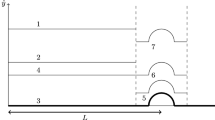Abstract
The distributed (over the longitudinal coordinate) excitation of two-dimensional (2D) Tollmien — Schlichting (TS) waves by weak non-stationary free-stream vortices propagating along the edge of the laminar boundary layer developing over a surface with small-amplitude 2D roughness is examined. The vorticity vector of the free-stream vortices was oriented over the span of the model, i. e., did not depend on the transverse coordinate. The theoretical analysis of the excitation mechanism reported in [1] was refined to develop, around it, a procedure making it possible to experimentally determine the coefficients of distributed vortical receptivity of the flow and the coefficients of “vortex-roughness” receptivity by fitting the experimental distributions with analytical solutions. Under conditions with controllable excitation of disturbances, a detailed hot-wire study of free-stream disturbances and boundary-layer disturbances at several vortex frequencies and at several surface-roughness periods was performed, and the shape of the controllable surface roughness was measured. The point-source method was employed to experimentally examine the characteristics of linear three-dimensional (3D) stability of the flow to TS waves, necessary for determination of the coefficients of distributed receptivity. It was found that the free-stream vortices with transverse orientation of the vorticity vector excited boundary-layer TS waves via two receptivity mechanisms: (a) on the smooth surface (due to natural non-uniformity of the flow) and (b) during interaction of the vortices with the surface roughness. The developed approach was used to experimentally estimate the amplitudes and phases of the coefficients of both types of distributed vortical receptivity as dependent on problem parameters. The absolute values of both types of receptivity coefficients were found to rapidly grow in value with increasing vortex frequency. It is shown that the most efficient excitation of TS waves is observed in the situation with satisfied resonance conditions for streamwise vortex, surface-roughness, and TS-wave streamwise wavenumbers, resulting in strong deviation of the increments of the TS waves from the linear-stability increments. Under no-resonance conditions, only amplitude beats of boundary-layer disturbances were observed.
Similar content being viewed by others
References
V.I. Borodulin, A.V. Ivanov, Y.S. Kachanov, and A.A. Fedenkova, Distributed boundary-layer receptivity to nonstationary vortical disturbances with wall-normal vorticity in the presence of surface roughness, Thermophysics and Aeromechanics, 2004, Vol. 11, No. 3, P. 355–390.
Y.S. Kachanov, V.V. Kozlov, and V.Ya. Levchenko, Production of Turbulence in Boundary Layer [in Russian], Novosibirsk, Nauka, 1982.
Y.S. Kachanov, Three-dimensional receptivity of boundary layers, Eur. J. Mech., B/Fluids, 2000, Vol. 19, No. 5, P. 723–744.
V.I. Borodulin, A.V. Ivanov, Y.S. Kachanov, and V.Y. Komarova, An experimental approach to investigation of distributed boundary-layer receptivity at scattering of non-stationary 2D free-stream vortices on surface waviness, Proc Intern. Conf. on Methods of Aerophys. Res., Pt II, Novosibirsk, Nonparel, 2004, P. 24–30.
W. Wuerz, S. Herr, S. Wagner, and Y.S. Kachanov, A first experimental approach to the distributed 3D vortex receptivity of a boundary layer on an airfoil, Proc. Intern. Conf. on Methods of Aerophys. Res., Pt II, Novosibirsk, Nonparel, 2002, P. 173–178.
L.S. Pontryagin, Ordinary Differential Equations, Nauka, Moscow, 1974.
Y.S. Kachanov and A. Michalke, 3D instability of flat-plate boundary layers: Theory and experiment, Eur. J. Mech. B/Fluids, 1994, Vol. 13, No. 4, P. 401–422.
Y.S. Kachanov and T.G. Obolentseva, Development of 3D perturbations in the Blasius boundary layer. 2. Stability characteristics, Thermophysics and Aeromechanics, 1997, Vol. 4, No. 4, P. 373–384.
V.M. Gilyov, Y.S. Kachanov, and V.V. Kozlov, Development of a spatial wave packet in boundary layer, Izv. SO AN SSSR, Ser. Tekhn. Nauk, 1983, Iss. 3, No. 13, P. 27–37.
A.J. Dietz, Local boundary-layer receptivity to a convected free-stream disturbance, J. Fluid Mech., 1999, Vol. 378, P. 291–317.
Author information
Authors and Affiliations
Additional information
This work was financialy supported by the Russian Foundation for Basic Research (Grant No. 03-01-00299).
Rights and permissions
About this article
Cite this article
Borodulin, V.I., Ivanov, A.V., Kachanov, Y.S. et al. Distributed two-dimensional boundary-layer receptivity to non-stationary vortical disturbances in the presence of surface roughness. Thermophys. Aeromech. 13, 183–208 (2006). https://doi.org/10.1134/S086986430602003X
Received:
Issue Date:
DOI: https://doi.org/10.1134/S086986430602003X




